Astronomical Telescope Recommendation: Detailed introductions to 8 astronomical telescopes, real-time update 20 astronomical telescopes best-selling list, and sharing how to buy your first astronomical telescope.The alternation of the sun and the moon rises, the stars that are extremely destroyed in the night sky, and the fleeting meteor is the best object of people’s entrustment of beautiful wishes.
Directory of this article
- What is an astronomical telescope?
- Basic structure of astronomical telescope
- Basic principles of astronomical telescope
- Basic parameters of astronomical telescope
- How to choose astronomical telescope?
- Astronomical Telescope Recommendation
- common problem
What is an astronomical telescope?
Astronomical telescope is a instrument that uses different optical principles to shorten the visual distance between humans naked and space objects, so that humans can observe and observe celestial bodies and understand celestial information.
The first astronomical telescope was invented in 1609, and Italian scientist Galileo invented.The opportunity was in 1608, a Dutch glasses manufacturer occasionally discovered that two different lenses were stacked.You can see very far objects.Galileo conducted multiple tests after learning about it.The first astronomical telescope is used to observe the sky.This most basic telescope uses the principle of light, so it defines it as refracting telescope.
Then, in 1663, Scotland Gaoli tried to use the principle of light to create a new astronomical telescope, but the immature craftsmanship caused this type of telescope to not be recognized by the public.In 1667, British scientists Newton made improvements on the basis of their predecessors.The principle of reflection was successfully applied to the telescope to make reflex telescopes.Compared with reflecting telescopes, the caliber of reflecting telescope was smaller, the magnification was greater.The color difference caused by the refraction telescope was eliminated, and it was admired by people.Later generations called Newton to reflect the telescope.
Subsequently, people studied in-depth research and developed various astronomical telescopes, including Kasai Green-style reflex mirrors, Schmidt-style telescope, etc., and also composed of composite telescopes that reflected in one.Astronomical observation is more ordinary, and it is no longer an extremely high-end study.
However, even if there are many types, the basic structure, basic principles, and basic parameters of astronomical telescope are relatively uniform.
Basic structure of astronomical telescope
Astronomical telescope mainly includes objective mirrors, main lens pockets, eyepiece, and brackets used when needed.
1.object mirror
It is located at the farthest end of the telescope.The main purpose is to gather the light from the observed objects in the distance.
2.The main mirror body
The largest part of the astronomical telescope is the largest part.The main role is to keep the mirror and maintain a suitable distance from the eyepiece.At the same time, it can prevent the into the light reflex/refractive area of dust and humidity.Essence
3.Eyellasses
At the focus, the purpose is to amplify the focus image of the objective mirror and present it on the human retinum, the function is similar to the magnifying glass.
4.Book
The observation of the stars often takes a longer time or even all night, so if it is handheld, it challenges the human body.
For the depth of observation of the astrological body, there are many requirements for object mirrors and lens, which makes astronomical telescopes have a variety of specifications.The famous Haier telescope, single lens is 14.5 tons.Well, this kind of professional-level is not within the scope of daily consideration, but even for the astronomical telescope used for daily observations, the weight is not comparable to ordinary binoscopes, let alone observation for a long time.
Furthermore, it is also the most important.Due to the significant shortening of the distance, the finest movement of the telescope will also cause the observed position to change orderly.Therefore, when observing the starry sky, stable support and fine adjustment are needed to change the direction of observation, etc.This is the importance of brackets.
Some senior astronomical telescope will be equipped with equatorial meters.The equatorial instrument is a device that rotates the instrument with a shaft parallel to the earth’s rotation axis to rotate with the sky rotation.The device that can be allowed to be connected above it only needs to drive a shaft at a fixed rate to track the sky to track the sky.Any celestial body running on Sunday.
Basic principles of astronomical telescope
At present, the optical principles of conventional astronomical telescope are mainly refracted telescopes, reflecting telescopes and refractive telescopes.
A.Reflection telescope

The refractive astronomical telescope was initially invented by Galileo.At first he used convex lens as objective mirrors and concave lenses as eyepiece.Based on this, he upgraded to become a Galileo telescope.Then Capeler changed the eyepiece to a convex lens and found that he had obtained a larger field of vision, so the telescope that was promoted was called the Campler-style refractive mirror.
The refraction process brings the light of the observed objects on the focus of the light shaft, so that the distant objects look brighter, clearer and larger, but the color difference will occur, sometimes even serious.In the later period, people invented two types of use two typesDifferent color scattered glass is used as a material mirror to improve the problem of color difference.
The characteristic of the refraction mirror is that the lens cylinder is long, it will have a color difference, it is easy to install and maintain, and the weight is relatively not heavy.It is suitable for entry-level observer.Most pore diameters are less than or equal to 80mm telescope.This is because small lens is easy to manufacture and cheap.
B.Reflecting telescope
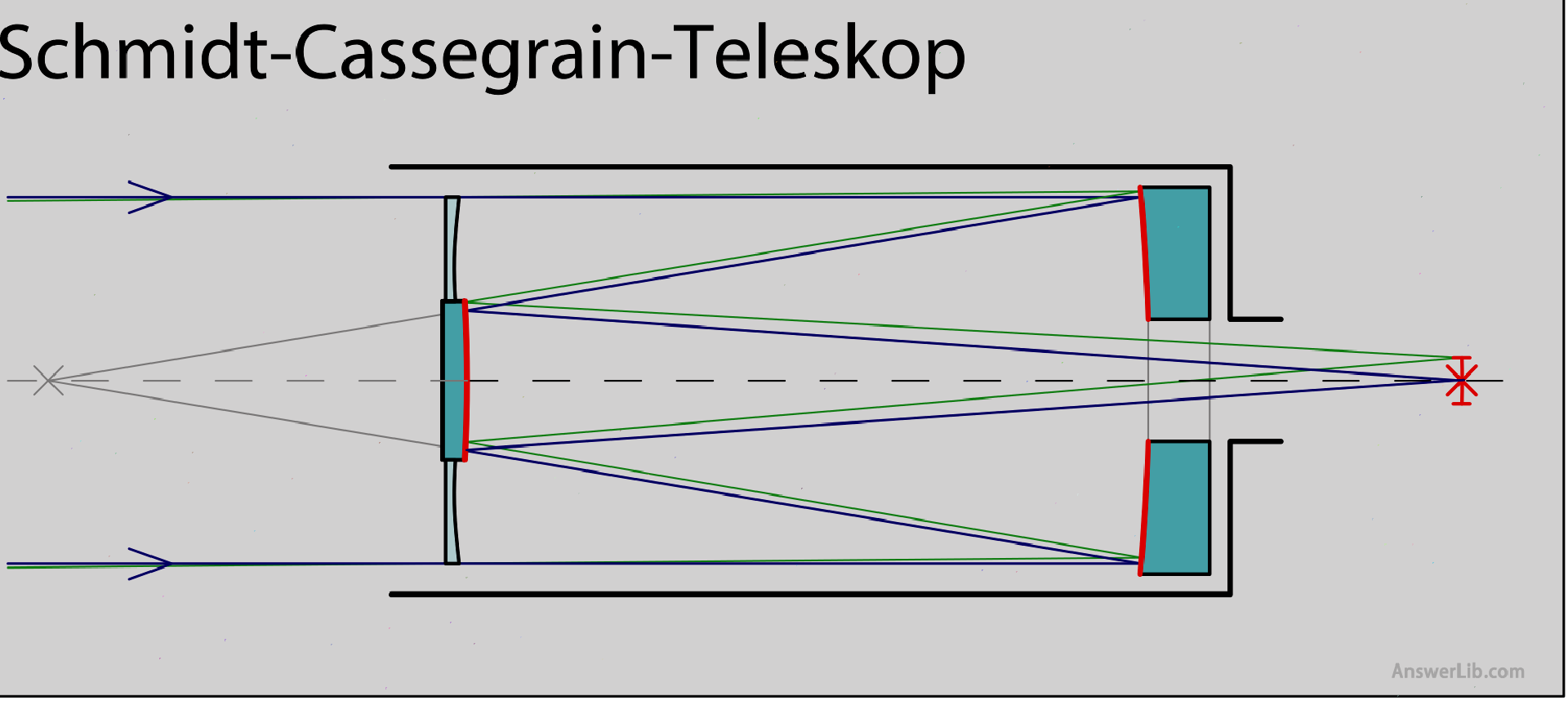
The reflex system was originally developed by British scientist Newton.It uses a certain angle combination of spherical reflex mirrors and concave reflex mirrors to achieve the purpose of meeting the inner focus of the mirror and as a result.Later generations call it Newton-style telescope.In 1672, the French proposed another reflex model that solved the color difference problem well through the combination of parabolic or dual-curved concave reflective mirrors and bilateral convex reflectors.
The characteristic of the reflector is that the cost is cheap.This is due to the cost of the reflector than the lens.The lighting effect is good.The barrel will cause the appearance and telescope itself to be affected by air flow, dust, water vapor, etc.in the later period, and the weight is generally large.
[Remarks] Ballis difference: Ballo-shape difference refers to the light of the object’s light through the lens refraction or the facial mirror reflection, and the light close to the center and near the edge cannot gather the image to a pointPhenomenon.
C.Folding telescope
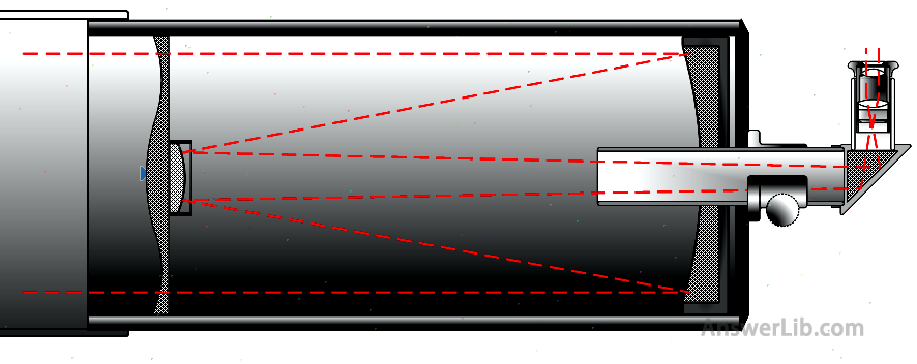
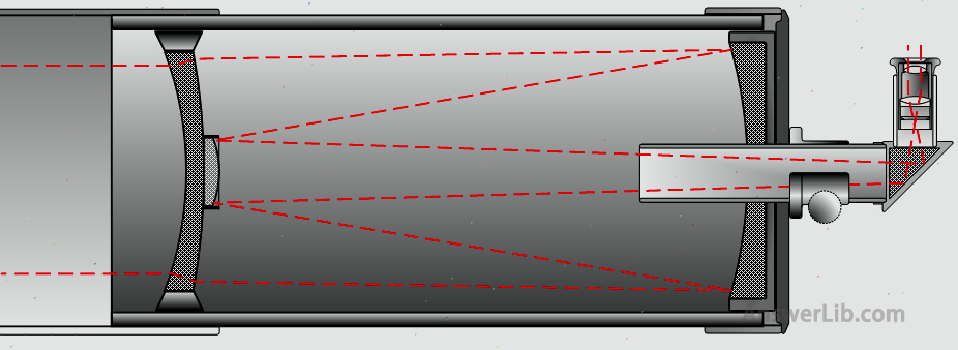
The reflection telescope is used to combine the lens and reflecting telescope used by refracted telescopes.The light will be used through the reflection of the lens and then the reflection of the mirror will be gathered to the focus.The problem, at the same time, different types of correction boards also optimize the use effect and cost cost of the telescope.Initially, Schmida Caseglin-style telescope invented by German Opticist Schmidt, adding a non-spherical lens close to the plane at the front end of the lens barrel as the Schmidt correction board, can effectively eliminate the gap.Subsequently, the Soviet Optician Mark Sufu improved, and the correction board was changed to a spherical lens to obtain a longer focal length.
The characteristic of reflective telescope is to avoid color differences, ball differences, easy care, and large-scale adjustable range, which is very suitable for amateur star observer.
Basic parameters of astronomical telescope
The basic parameters of the astronomical telescope mainly include diameter, focal length, focal length ratio, and magnification.
1.The diameter of the telescope
The diameter is the diameter of the telescope mirror, and the size of the caliber determines the resolution of the optical system.The larger the diameter, the more the telescope can accept more light sources, and the darker celestial bodies can be observed; the large caliber can also increase the magnification and resolution of the telescope, and more clear details can be observed.The symbol is D and the unit is MM.
2.The focal length of the telescope
The distance between the focal length of the telescope to the focal point determines the size of the observed object on the focal plane.The longer the focal length, the larger the image of the focal plane, and the smaller the other.The symbol is F and the unit is MM.
3.The focal length ratio of the telescope
Expect the focal length of the remote mirror to the diameter of the objective mirror, which is called aperture value in the photography industry.It can be used to determine the brightness performance of different telescopes.The smaller the focal length than the value, the brighter it is.In the same case, the shorter the exposure time of the shooting.The symbol is f.
4.The magnification of the telescope
Also known as the ratio, it is the ratio of the focal length of the objective mirror to the eyepiece.The larger the magnification, the greater the image you see.Therefore, the same astronomical telescope can be observed with eyepiece with different focal length values.
From this, for example, a astronomical telescope labeled: 60/700, using a eyebels with a focal length of 10mm, then its caliber is 60mm, the focal length of the material mirror is 700mm, the focal length ratio is 700/60 = 11.7, and the magnification is 700/10 to 700/10= 70 times.
How to choose astronomical telescope?
If you want to conduct star-viewing activities, explore the mystery of the sky, and to ensure that there is enough time, economy, and energy, although the cost of astronomical telescope has been decreasing, it is still not a cheap range.At the same timeThe time, or even the one-night, whether it will affect daily work and life deserves deeply.If these are not problems, look at what points you need to pay attention to before starting.
1.Use occasion
This is a relatively large boundary point.If you just want to watch the starry sky quietly in your own yard, there will be no restrictions on the size requirements of the telescope, but if you want to move around and find the ideal star watching pointIt is easier to disassemble the assembly and mixing astronomical telescope.
2.Activity
The most important component of the telescope is the material mirror.Near the coke, find the specifications of the telescope at the front of the lens barrel or on the box to understand the caliber size of the material mirror.
The aperture of human naked eyes is only 7 mm, about 0.28 inches.This means that the light collected by a 70mm telescope is 10 times that of your eyes, which is enough to reveal the amazing details on the moon, and provide a pleasant vision for all planets, including hundreds of star groups, Nebula and galaxies.The larger objective mirror caliber can make you see darker objects and more fine details.
But it doesn’t require a larger caliber.Your viewing position will play a main decision.If you are far away from the city’s lights, a good small-caliber astronomical telescope can still bring you a good stargazing experience, such as in it, such as in it inIn a dark place, you can find dozens of galaxies through a telescope with a diameter of 80 mm.But if you want to see the same galaxy from a typical suburban backyard, you may need 150 mm or 200mm telescope to do.At the same time, the larger the caliber means the higher the expenditure.
However, no matter how bright or dark the sky you live, the scenes watching through a large-caliber telescope are more fascinating than observing the same object in a smaller caliber.
3.focal length
Each telescope has a focal length, and this is not always the same as the length of the lens barrel.According to the different light reflection and reflection method in the lens barrel, the same focal length telescope may have different size lens cylinders.Generally, the refractive system is used.The length of the telescope, the length of the lens barrel will be proportional to the focal length, that is, the length of the focal length determines the size of your telescope, and the short-focus telescope is relatively suitable for carrying.The size of the lens barrel of the reflex system is not necessarily related to the length of the focus length, and there are more options, and the focal length is generally more than 1000 mm.
The focal length can be found on the nameplate of the telescope, usually between 400 ~ 3,000 mm.Eye mirrors also have focal lengths, usually for example, 25 mm or 10 mm.The length of the focal length will be decided to amplify multiple under the size of the same eyepiece.For small and medium-sized telescopes, the focal length of more than 1000 mm is roughly calculated as the telephoto.Long and short focus.When choosing, you need to combine the focal length and diameter size of the eyepiece to determine.
4.Focus ratio
After understanding the concept of focus ratio, when choosing an astronomical telescope, the significance of this value can be understood:
If the diameter of the objective mirror is unchanged, the longer the focal length of the objective mirror, the larger the focal length ratio, and the higher the magnifying multiple;
If the focal length of the material mirror, the smaller the focal length than, the higher the magnification multiple, but the image will be brighter and the field of vision will be greater.
The following is the long-short focus of distinguishing the telescope according to the focal length than the telescope, and the more suitable observation object:
- Short focus distance telescope: small focal length ratio, focus ratio ≤6, suitable for observing nebula and looking for comets;
- Physicide long-focus telescope: large focal length ratio, focal length ratio> 15, suitable for observing the moon and planets;
- Mid-focus distance telescope: mid-focal length ratio, 6
5.magnifying multiple
Any telescope can theoretically provide almost infinite magnification, which can depend on the eyepiece used.Is it better to observe the celestial body?Obviously not.The amplification multiple depends on the ratio of the focal length of the objective mirror and the focal length of the eyed mirror, but the clarity of the image depends not only on these two points.If you simply take the eye mirror focal distance to expand multiple.Can’t see clearly, or make the bright objects very vague.So there is a clear and important point, the diameter of the mirror, that is, how bright it can absorb.
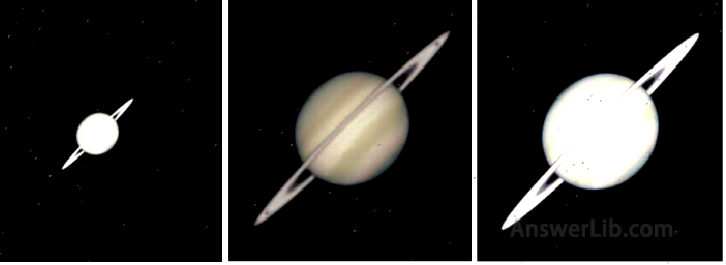
These images are made of the appearance of Saturn through different sizes of the appearance of the Hubble Space Telescope.The picture on the left shows the appearance of Saturn in the 2.8 -inch mirror.The view becomes dull and blurred when using a highly large mesh mirror to enlarge this view.Therefore, when you need to view a relatively bright and clear view (right), in addition to high-picked high-rate eyepiece, a larger mirror caliber is required.
The total range of actual amplification multiple is about 4 to 50 times per caliber, and the magnification between 8 times to 40 times per inch of diameter is more practical.
6.bracket
We already know the role of the telescope bracket.Usually, they have two types: they:
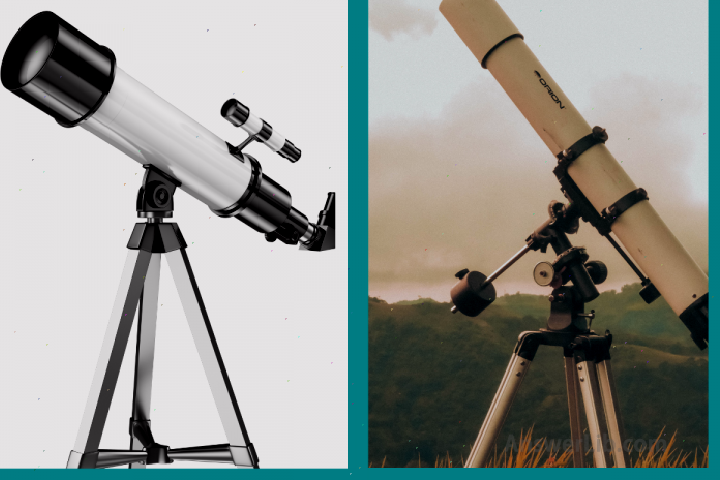
The telescope bracket can be attributed to two basic types【source】The
- Alt-AZ “bracket (left on the left), allows the telescope to move up, down, left and right, it is set quickly and easy to use
- The equatorial instrument (right side of the figure above) can rotate only one shaft to track the celestial body, and can be more easily mobility, but to make it work normally, it must be aligned with the Arctic Star Arctic Star.
Some telescopes have their own small electric motor that can move by their own keyboard buttons.In this more advanced bracket model, a small computer is built-in manual control device.After entering the current date, time and position, the telescope can point itself to the correct direction and track thousands of celestial bodies.
In addition, for astronomical photography enthusiasts, the aperture of the telescope, that is, the diameter of the objective mirror is not so important, because it can make up for it by long-term exposure, on the contrary, a very good equatorial instrument is required to accurately locate the observation orientation.
Generally, the price of a high-quality bracket may be higher than the telescope.
Astronomical Telescope Recommendation
Telescope recommendation | Optical principle | caliber mm | The focus of the material mirror mm | Bymposcopy focal length mm | Focal length ratio F | gain |
|---|---|---|---|---|---|---|
| Gskyer Children’s Astronomical Telescope | 70 | 400 | 10/25 | 5.7 | 4/16 | |
| Celestron-Astromaster | Newton | 130 | 1000 | 10/20 | 7.7 | 50/100 |
| Celestron-NEXSTAR 127SLT computer telescope | Mark Sotov-Caseglin | 127 | 1500 | 9/25 | 12 | 60/167 |
| Orion 09007 astronomical telescope | Reflector | 130 | 650 | 10/25 | 5 | 26/65 |
| Celestron-NEXSTAR 8SE Computer Astronomy Telescope | Schmidt-Caseglin | 203.2 | 2032 | 25 | 10 | 81 |
| Solomark astronomy telescope | Refractive mirror | 70 | 700 | 10/20 | 10 | 35/70 |
| Solomark polaris 130EQ Newton professional astronomical telescope | Reflector | 130 | 650 | 10/20 | 5 | 33/65 |
| Celestron travel portable astronomical telescope | Refractive mirror | 70 | 400 | 10/20 | 5.71 | 20/40 |
1.The most suitable for children’s astronomical telescope: GSkyer children’s astronomical telescope
Affiliate Link
Features of telescope
- Small size
- Easy installation
- The new generation of eyepiece design is comfortable
Telescope Introduction
GSkyer Children’s astronomical telescope, a 70mm-caliber full-coating optical glass lens, has high radio-coating, obtains high-definition portraits while protecting children’s delicate eyes.
Provide 2 replaceable new generation mirrors and a 3 -twice mirror.With the viewfinder with a bracket and the internal cross line, it can easily position the observation goals.EssenceThe use of a new generation of eyepiece is more comfortable, allowing small observer to spend enough time to explore.
The adjustable aluminum alloy triangle bracket is firm and stable, easy to disassemble, and children can be assembled by themselves.They are equipped with travel packs to make observation without geographical restrictions.
Provide a smartphone adapter and a wireless camera remote control for free.You can easily explore the world through the mobile phone screen and take amazing celestial images.
2.Senior astronomy telescope for beginners: Celestron-Astromaster 130EQ Newton telescope
Affiliate Link
Features of telescope
- Small size, easy to carry
- The bracket has an equatorial instrument, which is convenient for stable observation
- Free astronomy learning software
Telescope Introduction
Celestron Astromaster130EQ telescope is a Newton-style reflected telescope.It is a high-end reflection telescope for beginners of astronomy.It has a high-quality 130mm full-coating glass light school mirror.
The solid and light Astromaster bracket is equipped with a manual German equatorial instrument, and has two slow motion control knobs, which allows you to make it stable, accurately adjust, and set fast and simple, without the need for assembly tools.
With 2 eyepiece mirrors, the StarPointer red dot seeing mirror and adjustable tripod can be used to obtain a clear and accurate celestial image in any terrain.
It also provides customers with the highest evaluation Starry Night astronomy learning software program, and obtain comprehensive professional knowledge explanations during the exploration process.
3.The most intelligent astronomical telescope: Celestron-NEXSTAR 127SLT computer telescope
Affiliate Link
Features of the telescope:
- Intelligent program can automatically locate observation target
- Compact design is suitable for the whole family to travel in various occasions
Telescope Introduction
Celestron-Jexstar 127SLT Computer Telescope is a Mark Sotov-Caseglin-style telescope with smart programs.The unique “Sky Journey” program will automatically generate the best target of the currently visible target according to your exact time and location.The list, and your observation target is accurate and carried out.The preset value has more than 40,000 databases of stars, galaxies, nebula, etc.The telescope will be positioned accurately.
The easy-to -loading design and easy-to -carry compact volume can satisfy you and children, and observe nature when camping and browsing at night.
Use Skyalign for fast setting: Celestron’s exclusive Skyalign program enables you to observe the star in a few minutes.As long as the three bright objects in the eyepiece, Nexstar SLT can be aligned with the night sky, so as to find thousands of objects.
It is also equipped with a red dot StarPointer viewfinder mirror and 2 eyepiece (25mm and 9mm), and a adjustable full-high steel tripod with an attachment tray, allowing you to observe nature anytime, anywhere.
4.The telescope for the most suitable for intermediate astronomical observer: Orion 09007 astronomical telescope
Affiliate Link
Features of telescope
- Large-diameter mirror, high concentration, showing more clearly
- The equatorial bracket, the calibration is more accurate and stable
- The low focal length ratio is like bright, the field of vision is wide
- Lightweight volume is easy to carry
Telescope Introduction
Orion 09007 astronomical telescope is equipped with 130mm objective mirrors, which can observe clearer celestial images.
Compared with the 650mm focal length, it brings F/5 ultra-low focal length, making the image brighter and obtaining a broader field of vision.
With EQ-2 equatorial brackets and stable tripods, the target celestial body can be stable and accurate in any terrain.
In addition, two PLOSSL eyepiece and viewfinder work together with the equatorial instrument to bring a perfect observation experience.
Compact design, weighing only 27 pounds, is the perfect tool for intermediate celestial observations for outdoor observation.
The Starry Night SE software provided with the Federal Mirror can help observers to develop an observation plan and understand the observed content with the help of real sky simulation and many useful functions.
5.The largest diameter intelligent astronomical telescope: Celestron-NEXSTAR 8SE computer astronomical telescope
Affiliate Link
Features of telescope
- 203.2mm ultra-large caliber
- Intelligent system automatic positioning observation goals
- Small compact volume is easy to carry
Telescope Introduction
CELESTRON-NEXSTAR 8SE computer astronomical telescope adopts the largest caliber size in the recommendation list, 203.2mm, provides sufficient concentricity effects, with Schmida Caseigling’s reflected principle, shrink the lens barrel as much as possible, so as to achieve it in the lens.Get a high-quality star observation experience in small volume telescope.
The built-in Skyalign technology of the telescope contains more than 40,000 celestial databases, which can automatically locate and track observation objects.It is ready to be aimed at and prepare in a few minutes, which helps astronomy beginners to observe celestial bodies.
The design of the single fork arm and the solid steel tripod can be assembled and disassembled from a separate component to facilitate transportation.
Provide stars for free, for interactive learning astronomical knowledge.
6.The most suitable astronomical telescope for family observation: solomark astronomical telescope
Affiliate Link
Features of telescope
- You can mediate the height tripod to satisfy the whole family
- Improve the color difference of refraction mirror, improve the color difference between the refraction mirror
- Toolless design loading and unloading simple
Telescope Introduction
Solomark astronomical telescope is a astronomical telescope that is very suitable for family use.
The 70mm objective mirror with 700mm focal length and two specifications of eyepiece can meet the needs of daily observation.
Complete multi-layer coating optical glass lenses have high projection coating, which can show amazing image effects while protecting the eyes from harm.PLOSSL upgrades eyepiece to effectively improve color difference.
Control the knob with two directions, which can accurately align the observation target.
The whole bodyless tool assembly design can be quickly and easy to load and unload the telescope.Regardless of the indoor and outdoor, you can start to observe nature at any time.
The mobile phone adapter can cooperate with the observation of the observation of the eyepiece to record the novel discovery.
Stainless steel tripods can adjust the height at will to meet the observation needs of the whole family.
7.The most professional home astronomy telescope: solomark polaris 130EQ Newton professional astronomical telescope
Affiliate Link
Features of telescope
- Large-diameter mirror
- Stabilize equatorial instrument
- Low focal length ratio
- Moonlight filter
Telescope Introduction
Solomark Polaris 130EQ Newton professional astronomical telescope, with 130 mm large-diameter mirror, 650 mm focal length, obtains a low focal length ratio, and with specifications in 2 specifications, it is very excellent for astronomical observation and astronomical photography.
It has a full-coating glass optical mirror, is strong and lightweight, which can enhance the brightness and clarity of the image.Through it, you can enjoy the planets and the moon and the bright galaxies, the beauty of the nebula and the star group.
The solid and stable EQ German equatorial instrument, with slow movement control, can easily track the celestial body, set up fast and simple, no need to assemble tools.
With a 13 % transmitted moonlight filter with the mirror, it can help you get a more comfortable moon viewing experience.The light is softer and the image is clearer.
In addition, 1.5 times the large vertical multiplier mirror, viewfinder, and adjustable tripod.It is a more professional family astronomical telescope.
8.The most suitable astronomical telescope for travel: Celestron travel portable astronomical telescope
Affiliate Link
Features of telescope
- Light mirror
- Simple disassembly
- Special travel backpack
Telescope Introduction
CELESTRON travel portable astronomical telescope has all necessary components as an astronomical telescope, 70mm completely coated glass optical studio mirror, lightweight but solid, can meet all general observations, 400mm focal length, with a lower focal length ratio.Get a high-quality observation experience.
The lightweight Travel Scope manual Alt-Azimuth bracket makes the installation, disassembly, and carriers of the telescope mirror easily and fast, without delaying the journey at any time.
With the attached travel bag, you can stop at any moment of the journey to observe the natural sky.
common problem
Question 1: What is the English telescope?Astronomical telescope English is Telescope.It is an instrument that uses different optical principles to shorten the visual distance between humans’ naked eye and space objects, so that humans can observe and observe celestial body and understand celestial information.
See More
The parameters of the astronomical telescope are mainly:
1)
2) Focus
3) Focus ratio
4) A magnitude
See More
The astronomical telescope mainly composed of the following important components:
1) object mirror
2) Main lens cylinder
3) Eye mirror
4) Book
See More
Here are a few very good astronomical telescopes:
1) The most suitable for children’s astronomical telescope: Gskyer Children’s Astronomical Telescope
2) Senior astronomical telescope for beginners: Celestron-ASTROMASTER 130EQ Newton telescope
3) The smartest astronomical telescope: Celestron-NEXSTAR 127SLT computer telescope
4) The most suitable telescope for intermediate astronomical observer: Orion 09007 astronomical telescope
5) The maximum caliber smart astronomical telescope: Celestron-NEXSTAR 8SE Computer Astronomy Telescope
6) The most suitable astronomical telescope for family observation: Solomark astronomy telescope
7) The most professional family astronomical telescope: Solomark polaris 130EQ Newton professional astronomical telescope
8) The most suitable astronomical telescope for tourism: Celestron travel portable astronomical telescope
